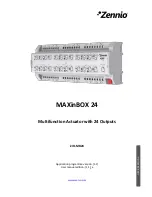
MOTOROLA
Chapter 33. Electrical Characteristics
33-3
Thermal Characteristics
33.2 Thermal Characteristics
Table 33-2 lists thermal resistance values.
Table 33-2. Thermal Characteristics
Characteristic
Symbol
Value
Unit
Junction to ambient, natural convection
Four layer board (2s2p)
θ
JMA
26
1,2
1
θ
JMA
and
Ψ
jt
parameters are simulated in accordance with EIA/JESD Standard 51-2 for natural convection.
Motorola recommends the use of
θ
JA
and power dissipation specifications in the system design to prevent device
junction temperatures from exceeding the rated specification. System designers should be aware that device
junction temperatures can be significantly influenced by board layout and surrounding devices. Conformance to
the device junction temperature specification can be verified by physical measurement in the customer’s system
using the
Ψ
jt
parameter, the device power dissipation, and the method described in EIA/JESD Standard 51-2.
2
Per JEDEC JESD51-6 with the board horizontal.
°
C/W
Junction to ambient (@200 ft/min)
Four layer board (2s2p)
θ
JMA
23
1,2
°
C/W
Junction to board
θ
JB
15
3
3
Thermal resistance between the die and the printed circuit board per JEDEC JESD51-8. Board temperature is
measured on the top surface of the board near the package.
°
C/W
Junction to case
θ
JC
10
4
4
Thermal resistance between the die and the case top surface as measured by the cold plate method (MIL
SPEC-883 Method 1012.1).
°
C/W
Junction to top of package
Natural convection
Ψ
jt
2
1,5
5
Thermal characterization parameter indicating the temperature difference between package top and the junction
temperature per JEDEC JESD51-2. When Greek letters are not available, the thermal characterization parameter
is written as Psi-JT.
°
C/W
The average chip-junction temperature (T
J
) in
°
C can be obtained from:
(1)
Where:
T
A
= Ambient Temperature, ×C
Q
JMA
= Package Thermal Resistance, Junction-to-Ambient, ×C/W
P
D
= P
INT
+ P
I/O
P
INT
= I
DD
¥ V
DD
, Watts - Chip Internal Power
P
I/O
= Power Dissipation on Input and Output Pins — User Determined
For most applications P
I/O
< P
INT
and can be neglected. An approximate relationship
between P
D
and T
J
(if P
I/O
is neglected) is:
T
J
T
A
P
D
Θ
JMA
×
(
)
+
=
Summary of Contents for ColdFire MCF5281
Page 124: ...3 20 MCF5282 User s Manual MOTOROLA EMAC Instruction Set Summary ...
Page 141: ...MOTOROLA Chapter 5 Static RAM SRAM 5 5 SRAM Programming Model ...
Page 142: ...5 6 MCF5282 User s Manual MOTOROLA SRAM Programming Model ...
Page 168: ...6 26 MCF5282 User s Manual MOTOROLA Interrupts ...
Page 186: ...7 18 MCF5282 User s Manual MOTOROLA Functional Description ...
Page 228: ...9 22 MCF5282 User s Manual MOTOROLA Functional Description ...
Page 246: ...10 18 MCF5282 User s Manual MOTOROLA Low Power Wakeup Operation ...
Page 254: ...11 8 MCF5282 User s Manual MOTOROLA Memory Map and Registers ...
Page 264: ...12 10 MCF5282 User s Manual MOTOROLA Chip Select Registers ...
Page 280: ...13 16 MCF5282 User s Manual MOTOROLA Misaligned Operands ...
Page 314: ...14 34 MCF5282 User s Manual MOTOROLA MCF5282 External Signals ...
Page 339: ...MOTOROLA Chapter 15 Synchronous DRAM Controller Module 15 25 SDRAM Example ...
Page 340: ...15 26 MCF5282 User s Manual MOTOROLA SDRAM Example ...
Page 356: ...16 16 MCF5282 User s Manual MOTOROLA DMA Controller Module Functional Description ...
Page 408: ...17 52 MCF5282 User s Manual MOTOROLA Buffer Descriptors ...
Page 446: ...20 24 MCF5282 User s Manual MOTOROLA Interrupts ...
Page 474: ...22 18 MCF5282 User s Manual MOTOROLA Programming Model ...
Page 510: ...23 36 MCF5282 User s Manual MOTOROLA Operation ...
Page 526: ...24 16 MCF5282 User s Manual MOTOROLA I2C Programming Examples ...
Page 672: ...28 12 MCF5282 User s Manual MOTOROLA Functional Description ...
Page 718: ...29 46 MCF5282 User s Manual MOTOROLA Motorola Recommended BDM Pinout ...
Page 750: ...32 8 MCF5282 User s Manual MOTOROLA Ordering Information ...
















































